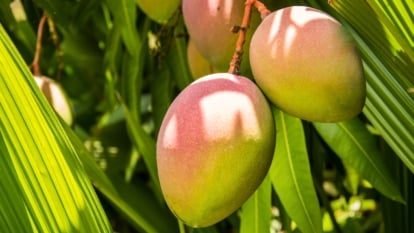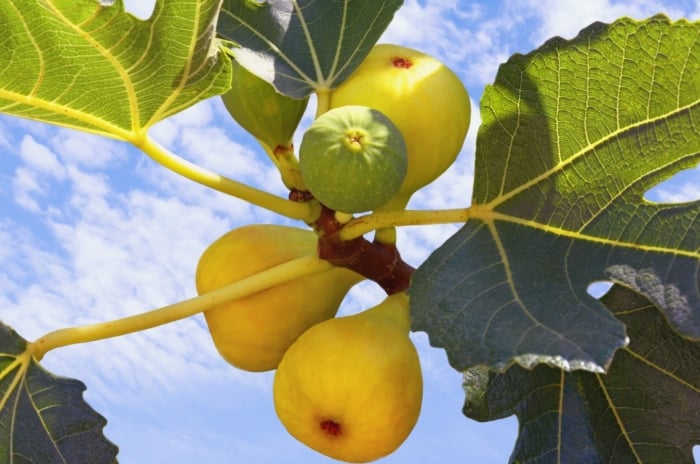How to Plant, Grow, and Care for ‘Glenn’ Mango Trees
‘Glenn’ Mango trees are great producers of mild-tasting, delicious and aromatic fruits. Check out this guide as gardening expert Melissa Strauss tells you what you need to know to get this plant off on the right foot in your space.

Contents
Super sweet and delicious, mangos are a tropical fruit with tons of personality and just a hint of spice. These stone fruits are best known for their bright orange flesh and syrupy-sweet flavor with peppery undertones. There are several hundred varieties of this fruit in cultivation around the world. Let’s talk about one of the sweetest varieties around, the ‘Glenn’ mango.
Overview

|
Plant Type
Evergreen
Family
Anacardiaceae
Genus
Mangifera
Species
Indica ‘Glenn’
|
Native Area
Florida hybrid
Exposure
Full sun to partial shade
Height
up to 30’
Watering Requirements
Low to Moderate
|
Pests & Diseases
Blight, canker, die-back, stem bleeding, anthracnose, capitata, botrytis, powdery mildew, hopper, beetles, weevils, thrips
Maintenance
Low to moderate
Soil Type
Well-draining sandy loam
Hardiness Zones
10-11
|
What is a Glenn Mango Tree?

‘Glenn’ is a variety of mango tree that comes from a seed planted in Miami, Florida, in 1940. It ended up on land belonging to a man named Roscoe E. Glenn. Initially, it was not especially popular. Although the fruits were good quality, they had some issues in terms of storage.
Over time, the tree gained notoriety for its popular characteristics and became more widely propagated. It is more disease-resistant than some other varieties. It also takes well to pruning, so it is easy to maintain at a manageable height. This makes harvesting the fruit much easier. Although the tree will reach up to 30 feet tall if left to its own devices, it makes a good container tree.
There has been some confusion over the lineage of this tree. The seedling was first publicized as the offspring of the ‘Haden’ mango. Glenn himself was unsure of this. He felt that the seed had come from a ‘Saigon’ mango. Many of its traits point to ‘Haden’ as the source of this cultivar, though.
Native Area

To determine the ultimate native range of this tree, we need to look at its potential lineage. If it was the offspring of a ‘Haden’ mango, is it a descendant of the ‘Malgova’ mango, this tree has its origin in South India.
If, however, the tree descended from a ‘Saigon’ mango, it has a different heritage. ‘Saigon,’ as the name suggests, is native to Vietnam. It came to Miami in 1902.
The place most commonly recognized as the home of this tree is Miami, Florida. Whether the parent was ‘Haden’ or ‘Saigon,’ the first recognized ‘Glenn’ mango grew in Miami.
Characteristics

The tree can grow quite tall if allowed to grow unchecked, but most growers maintain a smaller size by pruning. It is easy to maintain at about ten feet tall. The canopy has a rounded shape and dense foliage. It’s an attractive landscape tree that produces a moderate to large crop every year after it matures (three to four years).
The leaves are long and lanceolate. When they first unfurl, they have a pink cast, which quickly fades to lime green. As the foliage ages, it thickens and deepens in color to a dark, glossy green. Mango flowers closely resemble those of an avocado tree. The branching inflorescence has slender stems that bear a great number of small green blossoms.
The fruits of this variety are oblong and smooth. They ripen early in the season and are best eaten while yellow. As they continue to ripen, the fruit will first turn yellow and then take on a red blush, usually on one side. You can still eat them at this point, but the flavor will be more acidic.
In general, the flesh is soft and lower in fiber than other mangoes. This makes it easy to eat, as you can scoop it out of the skin with a spoon. The flavor is milder than most mangoes. If you like a strong-tasting mango with a peppery finish, ‘Alphonso’ has a more potent flavor profile. ‘Glenn’ is rich and sweet with a wonderful creamy texture. The skin of the fruits is delectably aromatic.
Propagation
Mango tree propagation can take many forms. It is possible to propagate by budding, inarching, and air-layering. However, the most common forms of propagation are from seed.
Seeds

To propagate a tree from seed, you will need a knife, scissors, a fruit, a zip-lock bag, potting soil, a pot, and moist paper towels or a tea towel. It is not a difficult process, and it’s a fun project to carry out with curious kids who enjoy gardening.
The first step is the tastiest, which is to eat the mango from which you intend to harvest the seed. ‘Glenn’ mangoes have creamy flesh without the fibrous texture that is common to many cultivars. As a result, it comes off of the seed easily. Make sure to remove any flesh left on the seed’s outer husk to prevent rotting.
After cleaning the seed husk, allow about one full day for it to dry. Use the scissors to cut open the end of the husk and then open it to expose the seed. The seed should be white, and any darkening means that the seed has begun to rot. A rotten seed is non-viable.
Moisten your tea towel or paper towels, and wrap the seed. Make sure to cover the seed completely. Place the wrapped seed in the zip-lock bag and place it in a warm, bright spot. A windowsill is ideal.
Leave your seed in the bag until it forms some green growth. The maturity of the mango, when picked, will determine the germination rate. A more mature seed will germinate faster. Germination can take a few days to a few weeks.
Once your seed has sprouted, prepare your pot by filling it with moist potting soil. A mixture of soil and coarse sand to improve drainage is best for this plant. Plant the seed so that the soil mostly covers the seed. Only leave the green growth uncovered.
Once potted, place your pot in indirect light for one week to help it adapt. Make sure to keep the soil moist at all times but not soggy. After one week, move the plant to full sun and watch it grow into a small tree!
Grafting

Grafting is a bit more complicated than growing your tree from seed, but there are advantages. A grafted tree will bear fruit significantly sooner than a tree grown from seed. It is for this reason that grafting is the most common method in commercial propagation.
Start with a healthy rootstock and a vigorous stem to graft to it. Your stem should be green and show signs of healthy growth. You will need about four inches of growth above the soil for your rootstock. Cut it with a sharp tool to make a clean, healthy cut. Take care not to damage the stem below your cut. Use your blade to split the stem in half, to about one inch from the ground.
The stem you graft to your rootstock should be the same thickness or just slightly narrower than that of your rootstock. Use your knife to cut the end of your branch or scion into a wedge shape. Shave away the bark from either side to create an angled point.
Gently insert the cut end of the branch into the cut in the rootstock stem. Line them up so that the exposed wood of both pieces is in complete contact. Secure the graft with grafting tape and cover the branch, including the grafted portion, with a plastic bag. Secure the bag just below the graft to form a small, makeshift greenhouse.
You will know your graft is successful when you see new growth on your grafted branch. Once new growth appears, remove the bag and tape, and keep the soil moist while your young tree develops further.
Planting

In preparation for planting your tree, water it thoroughly 24 hours ahead of time. This helps to minimize the stress on the plant’s roots, making them more pliable. Select a spot for your tree that gets at least four hours of sun daily, preferably six to eight.
Mangoes have deep taproots that help them reach moisture in the hot climates they are native to. Make sure that your tree’s roots won’t interfere with underground structures. This is not a good tree to plant near your home or septic tank.
Dig a hole that is as deep, and two to three times as wide as your root ball. Position the root ball in the hole and backfill around it with native or amended soil. Tamp down lightly to remove air pockets and water it in deeply.
If you are planting your tree in a container, choose a deep pot. You’ll want one that your tree can grow into.
How to Grow
Mango trees are warm-weather-loving plants. They like consistently warm temperatures and plenty of sunlight. Potted trees will thrive better outdoors during the warmer months if you are keeping one in a container. They can survive indoors, but they will need a brightly lit window.
Light

Technically, the ‘Glenn’ mango can grow in full or partial sun exposure. Realistically, your tree will grow better in full sun conditions. Ideally, your mango tree will bear the most fruit if it gets about eight hours of sun daily.
The more sun it gets in the early part of the day, the better. A bit of shade in the afternoon will help prevent dehydration, as this is a tree that likes humidity.
Water

During the first few weeks after planting, your tree will need extra attention in the water department. Water your new plant every other day for about three weeks. Remember that this plant develops a deep tap root. This will contribute to it being drought tolerant once mature, so watering deeply encourages deep rooting.
For the first year after planting, water your tree once a week. Avoid watering during times when regular rainfall keeps the soil moist. You don’t want to overwater, as these trees are susceptible to root rot. During extended dry periods, bump up your watering routine to twice weekly.
Once the tree is well established, you won’t have to give it supplemental water except in times of prolonged drought. In this event, water deeply once every two weeks.
Soil

Mango trees are not picky about soil as long as it is well-draining. They will grow in sandy, loamy, lateritic, and alluvial soil types. You may need to enrich your soil if it is very sandy. These trees are heavy feeders, and they like some moisture. Mix in some well-rotted compost if your soil is very sandy.
Clay soil may pose a problem for this tree as well. Mango trees need to grow that long tap root, and breaking through compacted, clay-heavy soil is difficult. If you are planting in compacted soil, make sure to loosen the soil in a significant space around the planting site. They can tolerate acidic and neutral soil, but alkaline soil may cause issues with nutrient availability.
Temperature and Humidity

Your mango tree can survive temperatures down to 25°F (-4°C) without any lasting damage. Young foliage, flowers, and fruit can sustain cold damage below 40°F (4°C). The optimal temperature for this tree is above 70°F (21°C).
These trees prefer humid weather. A level of 50% or higher is preferable, which is generally not an issue outdoors. If you’re growing this plant indoors, misting it regularly will help to keep it happy.
Fertilizing

Mango trees are heavy feeders, meaning that they use up a lot of nutrients, so they need regular fertilizing. This tree has high potassium needs, so choose a fertilizer that is heavy on potassium. A formula of 8-3-9 will provide your plant with the right balance of nutrients.
This tree will also benefit from some added iron. Iron helps to keep this tree’s roots strong and healthy. However, avoid chemical fertilizers, which can be too intense and cause problems for the tree long-term.
The active growth season for this tree is from spring through the end of summer. Use an organic fertilizer with beneficial bacteria like mycorrhizal fungi added, or use a fish-emulsion blend. Feed trees early in the spring with a balanced fertilizer to promote leaf development and later with a low nitrogen and high potassium fertilizer two to three times from May to October.
Maintenance

The time to prune your tree is immediately after harvesting. This allows the tree optimal time to heal and put on new growth before the following season. Use sharp loppers to prune your mango tree. Sharp, clean tools make cleaner cuts. Cleaner cuts heal faster.
Horizontal branches tend to bear more fruit, and managing the height of your tree will help make harvesting more manageable. Cut off any tall branches that grow vertically. Remove any water spouts, which are branches that grow straight up from another branch. Trimming your side branches by a foot or two will help your tree to produce more fruit.
In the spring, remove one of the main branches to encourage more robust fruiting on the other branches. Clear out any crossing branches or branches that are dead or damaged. You want your tree to put all of its energy into supporting fruit development.
Harvesting

Mangoes mature from May to September, but you can harvest them any time after they are fully filled out. The beak, which is the end opposite the stem, and the shoulders should be plump before you harvest. This typically happens about three to five months after flowering. Mangoes will mature at different rates, so you don’t have to harvest them all at one time.
Mango sap can be a difficult issue to deal with. When you cut the stem of this fruit, a milky sap will come out. If it gets on your skin, it can be irritating. The same is true of the mango’s skin. The sap can cause ugly lesions on your fruit, making it rot faster and look unattractive.
If you wait until your fruit is ripe, you should be able to pick it from the tree with a simple tug. A fruit that comes away easily is ripe. To harvest fruit before it ripens, use a sharp pair of hand shears and be careful to avoid letting that sap get all over.
Uses

Fresh mangoes are sweet, juicy, and in the case of the ‘Glenn’ mango, softer than the average mango. In addition to eating them fresh, there are lots of other ways to include these tasty fruits in your diet.
I love to add mango to green smoothies, as the sweetness and texture cover the vegetable taste. You can dry your mango slices or turn them into fruit leather for a sweet, chewy snack. Add mango to salads, seafood dishes, and baked goods.
Common Problems
Mango trees produce sweet, delicious fruit, so naturally, they attract some undesirable pests. Some diseases can affect these trees, as well.
Pests

Capitate, hoppers, aphids, thrips, beetles, weevils, and scales are all potential issues for this tree. Spider mites are attracted to mango trees, too, and can be very difficult to get rid of. When you grow this tree outdoors, keep an eye out for signs of insect infestation. Damage or curling of the leaves can indicate pests.
Many insects leave behind a sticky, sweet excrement called honeydew. This creates an environment for black sooty mold to grow, interfering with photosynthesis. Try to attract beneficial insects to your yard as a natural defense before using pesticides. Neem oil is a good alternative to other more toxic substances. Always treat your plants in the evening and when they are not flowering to avoid killing pollinators.
Diseases

Viral diseases are rare but not unheard of in these plants. Viruses don’t have a cure, but many of them don’t do long-term damage. Bacterial diseases like canker can cause issues for your tree and its fruit. Fungal diseases also present a threat. Many of these diseases are common in moist, humid environments.
Pre-treating your tree with a copper-based fungicide can help to prevent disease. The most important factor is prevention. Keep these diseases out of your yard by carefully introducing new plants. Plant in well-draining soil, and keep the interior of the tree pruned to allow for proper airflow.
Any fruit, leaves, or branches that display signs of botrytis or powdery mildew should be removed and disposed of. If your tree has had any disease issues, it’s important to rake up and dispose of any fallen plant matter. Keep your tree healthy by maintaining a hygienic culture.
Frequently Asked Questions
Are Mango Tree Leaves Poisonous?
No, the sap can be an irritant, and some people are allergic to it. Those with latex allergies should steer clear.
Can a Mango Tree Grow Indoors?
They can, but you’ll need to give them a lot of bright light. Keep your mango tree in a brightly lit window and make sure it gets sufficient humidity to grow it indoors.
Will Mangos Ripen After Being Picked?
Yes, as long as they are filled out and plump, you can pick your mangoes, and they will ripen off the tree.
Final Thoughts
‘Glenn’ mangoes are sweet, mild, and creamy. Their soft texture makes them easy to eat, and their mild flavor makes them a great choice for the home garden. Grow one of these attractive trees outdoors or indoors for wonderful fruit and pretty evergreen foliage.









